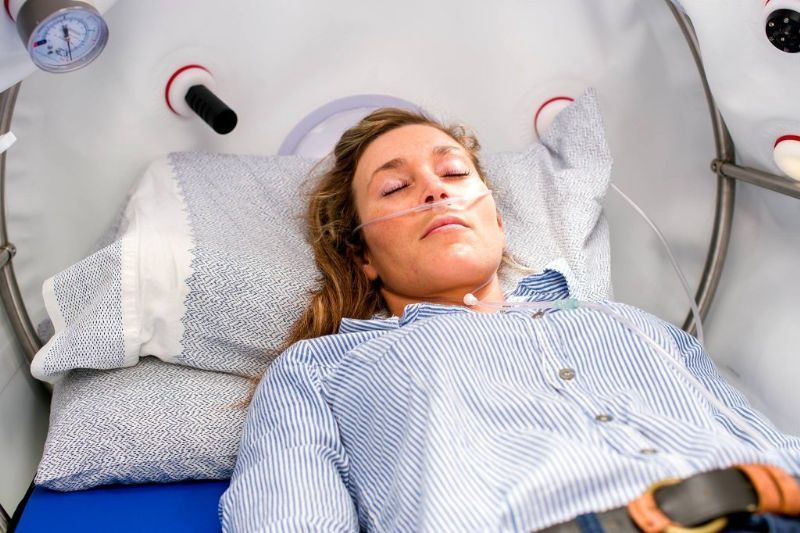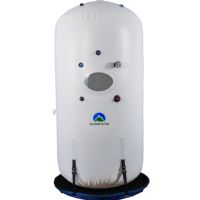 Written by Benjamin K. Mattox, DrPH, PA-C
Written by Benjamin K. Mattox, DrPH, PA-C
Hyperbaric oxygen therapy (HBOT) is an exciting treatment option that has shown promising results in helping stroke survivors recover. By exposing patients to pure oxygen in a pressurized chamber, HBOT increases the amount of oxygen carried in the blood, which can improve the brain's ability to heal and repair damaged tissue. Studies have shown that hyperbaric chambers can help reduce inflammation, promote new blood vessel growth, and improve cognitive function in stroke survivors. This non-invasive and painless therapy offers hope to those who have experienced the debilitating effects of stroke, and it is a shining example of the power of modern medicine to improve the lives of those in need.
Table of Contents |
Hyperbaric Oxygen Therapy (HBOT) is a form of therapy in which patients are exposed to an atmosphere of higher-than-normal air pressure, with oxygen levels up to three times higher than normal. This process increases the amount of oxygen that reaches the brain and other organs, which can help boost healing and recovery. This therapy has been used to treat a wide range of medical conditions, including decompression sickness, carbon monoxide poisoning, and wound healing.

A stroke occurs when the blood supply to the brain is interrupted, either by a blockage (ischemic stroke) or bleeding (hemorrhagic stroke). This interruption of blood flow can lead to brain damage, and the severity of the damage depends on the extent and duration of the interruption.
 | Dive Vertical 40 in Hyperbaric Chamber for Sitting Up - by Summit to Sea View Product |
During a stroke, brain cells are damaged or killed due to a lack of oxygen. However, studies have shown that HBOT can stimulate the growth of new blood vessels and increase the production of stem cells in the brain. This can promote brain healing and repair, helping to restore lost function and reduce the severity of disabilities.
Inflammation is a common response to injury, including stroke. However, excessive inflammation can cause further damage to the brain, leading to a longer recovery period. HBOT has been shown to reduce inflammation in the brain, which can help to minimize the extent of brain damage and improve recovery outcomes.
Stroke survivors often experience cognitive impairments, such as difficulty with memory, attention, and language. HBOT has been shown to improve cognitive function in stroke patients, helping them to regain some of their cognitive abilities. Additionally, to start the rewiring process in the brain, neuroplasticity must be maximized through repeated exercises. After using HBOT, the increased oxygen supply in the brain can enhance neural connection repair and regeneration. This implies that due to the heightened neuronal activity, stroke survivors may experience functional movement improvements more quickly.
HBOT can also improve blood flow to the brain, which is crucial for delivering oxygen and nutrients to brain cells. This increased blood flow can help to prevent further damage to brain tissue and support the healing process.
HBOT has been shown to reduce disability in stroke survivors. In a study published in the journal, “Stroke,” researchers found that patients who received HBOT had better outcomes in terms of motor function, activities of daily living, and overall disability compared to those who received standard care.
~1.jpg)
A: Hyperbaric oxygen therapy is not currently FDA-approved to treat strokes. More studies are needed to fully understand the potential benefits and risks of HBOT for stroke treatment. However, there is research suggesting that HBOT may have potential benefits for stroke patients, such as improving blood flow and reducing inflammation in the brain. And currently, HBOT for treating stroke survivors is a common off-label use. You can learn more by reading the list of FDA-approved & off-label uses of HBOT.
YES - for two reasons.
First, in good faith, I can’t tell you that HBOT will heal you; HBOT is not a “one-size-fits-all” treatment for stroke recovery. Stroke recovery is complex - brains are sensitive, conditions vary, and you might not even be a candidate for HBOT. Some research says HBOT is not effective for users with ischemic strokes (read more on the AHA/ASA Journals). The purpose of this article is to educate you on all the possible benefits of HBOT, so you can be informed on the matter before speaking to a doctor.
Secondly, is that hyperbaric chambers require a prescription, so you have to see a doctor regardless. I recommend consulting with a doctor that is knowledgeable about HBOT (versus any doctor that will write a prescription)!
Right here! RehabMart offers a nice selection of sizes, styles, and price tags to fit most needs. Browse our selection of Hyperbaric Chambers for sale.
Hyperbaric oxygen therapy is an increasingly popular treatment for stroke survivors that have been found to help in the recovery process.
HBOT has been shown to have several potential mechanisms of action that could help to mitigate the damage caused by stroke and help in the prevention of stroke. One of the primary mechanisms of action of HBOT is that it increases the amount of oxygen that is delivered to the brain. The pressurized environment of the hyperbaric chamber allows more oxygen to concentrate in the bloodstream, which can then be delivered to areas of the brain that may be experiencing reduced blood flow.
While HBOT is generally considered safe, it is important to consult with a healthcare provider before starting treatment. HBOT is not a replacement for standard stroke treatments such as medication and rehabilitation, but it can be used in combination with these therapies to enhance recovery outcomes.
We hope this helps!
Check out our Hyperbaric Blog where experts have explained important topics, like how to choose a hyperbaric chamber, the best chamber for home use, how do hyperbaric chambers work, and how to prepare for home treatment.
Review our selection of Hyperbaric Chambers for sale. We have many styles, brands, sizes, and price tags!

Benjamin K. Mattox, DrPH, PA-C
Orthopedic surgery physician assistant, doctor of public health, and owner of a public health consulting firm. With over a decade of Active Duty Navy Experience, Deployments with the Navy SEALS, and as a Professor for Purdue University - Dr. Mattox is a highly qualified and experienced clinician with a firm understanding of orthotic needs, rehabilitation, home access needs, gait therapy, and veteran-specific health needs.